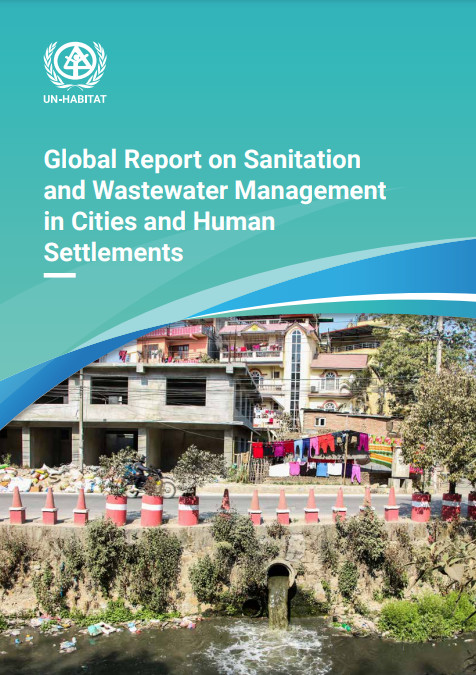Global Report on Sanitation and Wastewater Management in Cities and Human Settlements
 |
report Jun 2023 ; 192 pages
Ed. UN-Habitat - Nairobi
Downloadable format: PdF
Downloadable from the publisher
 Key Messages and Priority Actions
Abstract:
Key Messages and Priority Actions
Abstract:Recommendations of this report draw on a global review of the state-of-the art of urban sanitation and wastewater management.
This Global Report on Sanitation and Wastewater Management in Cities and Human Settlements is a global reference on sanitation and wastewater in urban settings. It takes stock of the sanitation and wastewater management situation, both in terms of service levels and the supporting functions required to enable service provision at scale. Drawing from existing literature and primary data in 18 cities across Africa, Asia, Europe and Latin America, the Report underlines the scale of the challenge in strengthening wastewater and faecal sludge management at the global level, while also highlighting actions being taken by governments, development partners, city planners, utilities, service providers and researchers around the globe. Focus is on water/sanitation service levels, containment and treatment systems, treatment performance, policies and regulations and institutional arrangement, planning and investment, monitoring, and financial performance.
The Report showcases detailed case studies in 5 of the 18 focus cities, providing an overview of key elements of wastewater and faecal sludge management and how authorities are proactively engaging with different thematic areas supporting the three core functions of Citywide Inclusive Sanitation (CWIS) of: resource planning and management, responsibilities and accountability, including city and national level sanitation data management systems climate resilience and emerging innovations.
The report shows that, for countries and cities starting from a low base point in sanitation and wastewater management, clarity is needed on what actions to prioritise and why. It offers a structuring framework to support such prioritisation by integrating the three CWIS core functions. Contents:
1. Putting sanitation and wastewater management centre stage .2
1.1 Bringing wastewater and faecal sludge out from the margins.2
1.2 Specific scope: wastewater and faecal sludge management in urban contexts.3
1.3 Methodology: combining theory with the state of the art in practice.4
1.4 Target audience: from decision makers and service providers to academia.7
1.5 Structure of this report.7
2. The global challenge of sanitation and wastewater management in urban contexts.9
2.1 The global urban shift .9
2.2 Sanitation infrastructure development: an urbanization challenge .10
2.3 Key features of the focus cities for this report .12
3. The impacts of poor sanitation and wastewater management .17
3.1 Health impacts .18
3.2 Environmental impacts .23
3.3 Socio-economic impacts.25
4. Wastewater and faecal sludge management performance.28
4.1 Current global estimates for wastewater and faecal sludge management across the sanitation service chain .28
4.2 Collection and conveyance .31
4.3 Wastewater and faecal sludge treatment performance: results from the Global Mapping .33
4.4 Climate change impact on wastewater and faecal sludge performance .42
5. Resource planning and management .45
5.1 Balancing master planning and financial viability.45
5.2 Costing wastewater and faecal sludge management.50
5.3 What sources of funds to cover these costs, and what financing instruments?.52
5.4 Case Study: Medellín and the Metropolitan Area of the Aburrá Valley, Colombia — a model of corporate governance for
public utility provision of sanitation services .58
6. Responsibilities .62
6.1 Mandate structures for urban sanitation and wastewater management .62
6.2 Service models and delegated management structures .64
6.3 Serving low-income areas and informal settlements .66
6.4. Gender mainstreaming within mandated service authorities.68
6.5 Case Study: Ouagadougou, Burkina Faso — extending sanitation services to informal settlements .70
7. Accountability.75
7.1 Responsibilities for regulating urban sanitation.75
7.2 Models for Regulation .76
7.3 Complementing accountability roles for sanitation .78
7.4 Accountability mechanisms .81
7.5 Case Study: Dhaka, Bangladesh — coordinating wastewater and faecal sludge management in a mega-city context 86
8. Data management and digitisation .90
8.1 City and national-level sanitation data management systems.91
8.2 Digitisation .93
8.3 Case Study: Nakuru, Kenya — Bridging the sanitation data gap.98
9. Emerging innovations.102
9.1 Wastewater and faecal sludge recycling, energy and nutrient recovery .102
9.2 Climate resilient systems.106
9.3 Wastewater-based epidemiology.109
9.4 Emerging treatment technologies .111
9.5 Case Study: Hanoi, Vietnam — Flood prevention via sustainable urban drainage systems and wastewater reuse.113
10. The way forward — bringing sanitation and wastewater management to the heart of urban development . 122
1. Invest more, and more smartly .123
2. Integrate wastewater and faecal sludge management services with wider urban development and slum upgrading
processes.125
3. Clarify mandates across the sewered and onsite sanitation service chains.127
4. Allocate human and financial resources to regulation for greater accountability.128
5. Radically improve country-level monitoring of wastewater and faecal sludge management.129
6. Implement measures for safe wastewater and faecal sludge valorization.130
References .132
Appendix .145
Keywords: |
sanitation (CI) (DT) (ET) (ope) , urban (CI) (DT) (ET) (ope) , wastewater (CI) (DT) (ET) (ope) , wastewater treatment (CI) (DT) (ET) (ope) |
Publisher/Broadcaster: |
|
UN-Habitat
-
United Nations Human Settlements Programme - Nairobi - Kenya |
If there is a broken link, we will be pleased to receive a message: communication@pseau.org